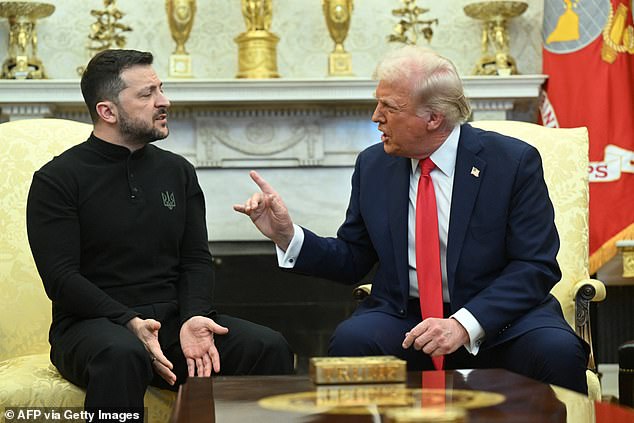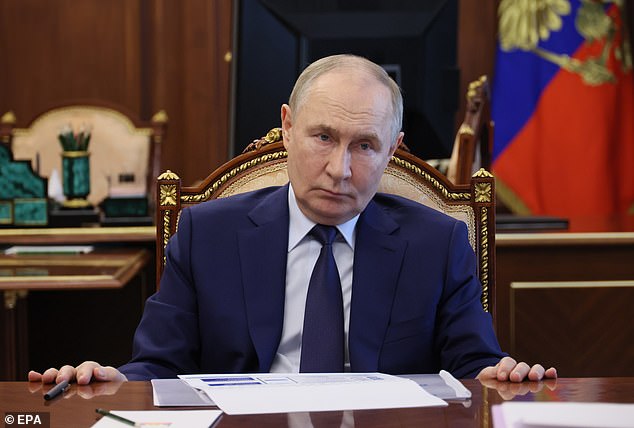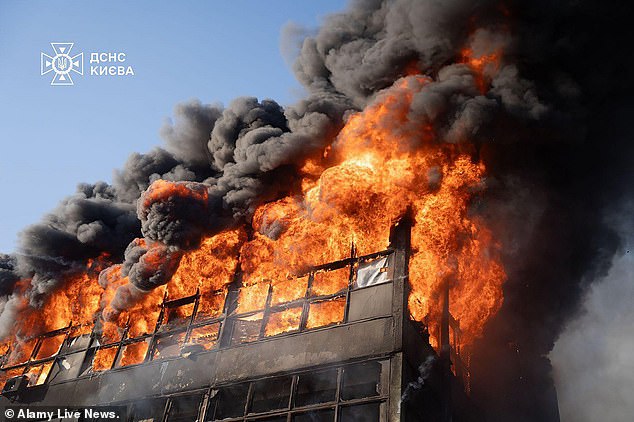What a difference four months makes. At the end of February, the Ukrainian cause had never looked more hopeless after the now-notorious televised confrontation between Donald Trump and Volodymyr Zelensky in the Oval Office.
When the Ukrainian president said, quite rightly, that Putin could not be trusted, Trump launched a brutal verbal assault, threatening to abandon him and his country unless he went along with Washington’s ceasefire plans.
But yesterday it emerged that, in a call with Zelensky on July 4 – America’s Independence Day – a bullish Trump had asked him whether he could take out targets deep in Russia.
‘Volodymyr, can you hit Moscow?… Can you hit St Petersburg, too?’ Trump asked, according to the Financial Times.
‘Absolutely. We can if you give us the weapons,’ Zelensky replied.
Ten days after this extraordinary exchange, the American President announced the supply of ‘billions of dollars’ of military equipment to Kyiv and issued a dire warning to Vladimir Putin that, if he didn’t make peace within 50 days, he would slap punitive ‘secondary tariffs‘ of 100 per cent on the countries that were buoying up the Russian economy by purchasing its oil and gas.
While many have been sceptical about how effective this ultimatum will be, I believe it will lead to a ceasefire.
But that would not be unalloyed good news.

At the end of February, the Ukrainian cause had never looked more hopeless after the now-notorious televised confrontation between Donald Trump and Volodymyr Zelensky in the Oval Office, writes MARK ALMOND
An end to the Russia-Ukraine war could well presage the beginning of a much more serious conflict. Indeed, it’s no exaggeration to say that it could put us on the road to World War III. Here’s why.
Trump’s 50-day deadline allows the Russians time to mount an intense summer offensive, in the course of which they can expect to make significant territorial gains.
This will enable them to arrive at the negotiation table from a position of strength. The Ukrainians, Putin hopes, will be battle-scarred, war-weary and demoralised.
Once the parties come together, Trump will deploy both the carrot and the stick. For the Kremlin, the carrot will come in the form of an acceptance that Crimea is theirs and it will be entitled to retain control of the roughly 20 per cent of Ukraine that it has managed to seize by force of arms.
But the Russians will not hold all the cards. Its economy is heavily reliant on the sale of hydrocarbons, with up to 25 per cent of Russia’s GDP coming from oil and gas revenues.
The idea that the threat of secondary sanctions might lead big trading partners such as China and India to stop pumping billions into its economy every year could well give Putin pause.
Even if Beijing and Delhi stand firm, EU countries – which currently buy large quantities of Russian oil from India, for example – might be persuaded to switch to American suppliers, delivering a big hit to Moscow’s bottom line in the process.
Then there is that implied threat by Trump to give Kyiv the means to bombard Russian cities in order to bring home to ordinary citizens ‘the pain of war‘.
Ukraine currently has very few long-range missile options. Its American ATACMS missiles have a range of 190 miles but have to be launched from ground-based launchers.
They also have aircraft-borne Anglo-French Storm Shadow cruise missiles, with a maximum range of around 155 miles, and German Taurus cruise missiles, which have a range of almost twice that.
The idea that the supply of such missiles would be ramped up and the Ukrainians would start flying sorties over Russian territory to attack not just Moscow and St Petersburg but munitions factories deep inside the country is enough to make anyone think twice before turning down an olive branch.

Trump’s 50-day deadline for Vladimir Putin to strike peace could allow the Russians time to mount an intense summer offensive
The twin threat of secondary sanctions and an enemy with superior firepower will, I am convinced, persuade Putin to talk turkey and reach a peace agreement.
And that’s when things will get really interesting – in a bad way.
Russia is now, essentially, a war economy. Since it launched its invasion of Ukraine in February 2022, investment has been concentrated on war-related industries, import substitution – the production of items denied it by sanctions – and infrastructure projects to facilitate trade with China.
If defence spending is scaled back, Russia’s economy would quickly stagnate with all the consequences that would have for the stability of Putin’s regime.
The truth is that, in such circumstances, the man in the Kremlin’s only option will be to wage yet more war. Many see the Baltic states – Nato members Estonia, Latvia and Lithuania – as the countries most vulnerable to the Russian bear but I reckon the people who should feel most threatened are its neighbours to the south: Armenia, Azerbaijan and Georgia – even Kazakhstan.
Russia has long seen the first three, known collectively as the South Caucasus, as within its sphere of influence. But as they form a bridge between Russia and its Middle Eastern ally Iran, they have taken on renewed strategic significance in recent months following Israel and the US’s bombing raids on that country.
With the Kremlin focused on its war with Ukraine, however, all three have been asserting their independence, with Armenia, for example, strengthening its ties with France and the EU.
Azerbaijan has been flexing its muscles, too. Its relations with Moscow hit a new low last week after two of its nationals died in Russian custody after being arrested in Yekaterinburg.
The authorities in Azerbaijan’s capital, Baku, cancelled all cultural events related to Russia, raided the local office of Russia’s Sputnik news agency and detained several people who were, judging by subsequent photographs, beaten up. All of this was accompanied by harsh criticism of Moscow in state-owned media.
In a post-Ukraine war world, Russia may well seek to remind these upstarts who’s boss.
It already has a threatening presence in Georgia’s breakaway region of Abkhazia, where it has been gradually relocating its Black Sea fleet from Crimea to avoid repeated Ukrainian strikes on the peninsula.
Meanwhile, when it comes to Kazakhstan, it would be simplicity itself to trump up charges that the authorities there were oppressing the 20 per cent of its citizens who hail from Russia and launch an invasion to ‘go to their aid’.

A fireball erupts after a Russian missile strikes the centre of Ukrainian capital Kyiv
If Putin did decide to reassert his dominance over his southern neighbours – or attack the Baltic states – he might well do it in co-ordination with his old friend Xi Jinping.
No less a personage than Mark Rutte, the former Dutch prime minister who is now secretary-general of Nato, warned about just such a danger earlier this month.
He told the New York Times: ‘If Xi Jinping would attack Taiwan, he would first make sure that he makes a call to his very junior partner in all of this, Vladimir Vladimirovich Putin, residing in Moscow, and telling him: ‘Hey, I’m going to do this, and I need you to keep them busy in Europe by attacking Nato territory.’
There is already a big debate going on in the Pentagon over whether it should be prioritising the maintenance of its allies and trading partners across the Pacific in the Far East rather than those on the other side of the Atlantic in Europe.
One of its main allies in the Far East, of course, is the island state of Taiwan, the world’s major producer of semiconductors – producing more than 60 per cent of the world’s most advanced computer chips.
But it is under grave threat from China because it is a strategic obstacle to Beijing’s ambition for its navy to have unhindered access to the Pacific Ocean.
America would expect the cooperation of regional allies Japan and Australia, as well as the UK, in fending off Chinese aggression.
For its part, China might well call upon its totalitarian neighbour North Korea to create yet another distraction by mounting incursions into South Korea.
In short, the end of hostilities in Ukraine could well set in train a chain of events that would lead to the mother of all wars.












